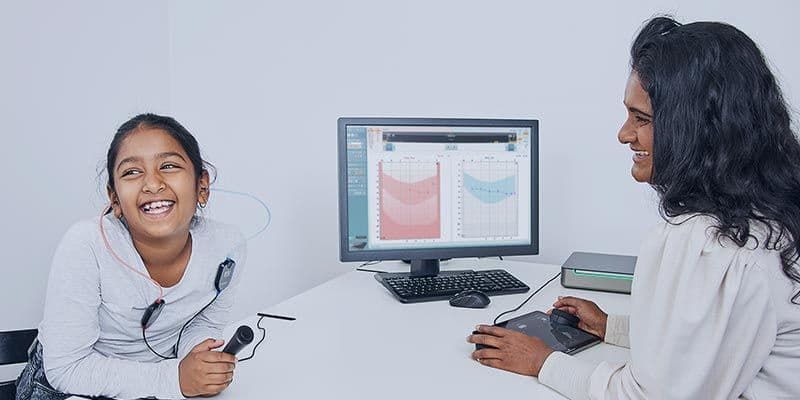The Future of Audiology: Latest Tech and Diagnostics Tools

The field of audiology is buzzing with some fantastic new technology and diagnostics tools that can enhance your practice. Here’s a look at the latest releases.

The field of audiology is buzzing with some fantastic new technology and diagnostics tools that can enhance your practice. Here’s a look at the latest releases.
The Equinox Evo is a versatile 2-channel audiometer that offers comprehensive testing for all ages. It functions as a PC-based and standalone device, offering flexibility and efficiency for hearing professionals. It includes advanced pediatric features and customizable assessments, from basic tests to the Audible Contrast Threshold (ACT™) test.
Interacoustics has an exciting new resource to help if you’re seeing pediatric patients for Play Audiometry! They’ve created an adorable video specifically for children, designed to walk them through the hearing test process in a fun and engaging manner.
This charming video is perfect for easing nerves and making the testing experience more enjoyable for young patients. Playful visuals and friendly explanations help children understand what to expect, ensuring a smoother and more cooperative testing session.
Pairing the Equinox Evo with the wireless Touch Keyboard offers PC-based audiometry and a modern, efficient keyboard experience. This wireless, ergonomic keyboard is designed to streamline the testing process, making it smoother and more efficient.
It’s particularly beneficial for pediatric testing, allowing for better interaction with young patients. Simply unplug the keyboard for in-booth functionality to keep your patients engaged like never before.
Interacoustics VisualEyes™ 3.2 introduces new tools that make vestibular testing more functional, and patient focused. The new fvHIT™ feature checks how well patients can see clearly during fast head movements, giving a better picture of their balance system.
Another new tool, the Self-Paced Saccade test, measures how quickly and accurately a patient moves their eyes between two points—helpful for identifying specific brain-related balance problems. These updates help clinicians better understand and treat dizziness and balance issues.
The Aided Cortical module for the Interacoustics Eclipse offers a reliable, objective method to confirm that speech sounds are reaching the auditory cortex—without requiring a behavioral response.
It’s especially useful for fitting hearing aids and cochlear implants in infants, young children, and individuals with complex needs, filling the critical gap between ABR and VRA testing.
With fast, comfortable, and precise measurements, it gives clinicians the confidence to fine-tune fittings early and provides reassurance to families during this important stage of auditory development.
The Verifit Skull Simulator is an innovative tool for verifying bone-anchored hearing devices (BAHDs). It uses new DSL-BCD targets in Speechmap® to ensure accurate audibility across frequencies.
Connect the skull simulator to the test box coupler microphone of your Verifit system. This device converts vibrations into electrical signals, precisely verifying BAHD performance.
The Skull Simulator is compatible with Verifit2 (software 4.12. x or later) and Verifit VF-1* (software 3.20. x or later).
The latest update to GSI AMTAS™ (Automated Method for Testing Auditory Sensitivity) introduces several enhancements to streamline audiometric testing. The update unifies the software for both the Pro and Flex versions, supports new audiometric tools, and includes a noise check enhancement for better testing environments. Additionally, the update integrates otoscopic images into reports, improving the overall functionality and efficiency of the system.
Designed for easy integration with GSI Suite, clinicians can review, store, and include otoscopy images directly in patient records—streamlining documentation and enhancing clinical reporting.
Its lightweight, portable design and USB power make it ideal for use in any exam setting, while the one-button capture function allows for quick, efficient imaging. This integration also supports better patient communication by providing clear visuals during consultations.
The MAICO easyTone tablet audiometer simplifies hearing screening with its intuitive tablet interface and streamlined workflow. It transitions seamlessly from sweep screening to pure tone audiometry, operated with just two buttons. Built-in noise monitoring ensures compliance with ambient noise requirements, making it ideal for various screening environments.
The MedRx AWRC combines a dual-channel audiometer with a high-frequency wireless Real-Ear Measurement (REM) system, perfect for mobile testing. It supports audiometry up to 20,000 Hz and includes wireless binaural Live Speech Mapping for accurate hearing aid fittings. Powered by USB, it integrates with software like Noah, TIMS, and Blueprint OMS for efficient data management.
The partnership between Flex VRA and HeyBear Sensory is set to revolutionize pediatric audiometric testing. Flex VRA, known for its engaging Visual Reinforcement Audiometry (VRA) system, now incorporates HeyBear’s popular sensory-based content.
This collaboration brings cheerful and captivating visuals to hearing tests, making them more approachable and effective for young children and those who may be harder to test. By integrating HeyBear’s videos, Flex VRA enhances the testing experience, keeping children engaged and cooperative throughout the process.

Other Good Reads: Aided Cortical Module: New Way to Validate Hearing Aids in Infants
For expert guidance on diagnostic equipment and tools tailored to your needs, contact your local sales consultant.